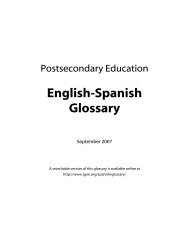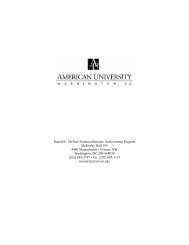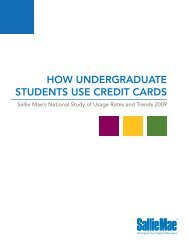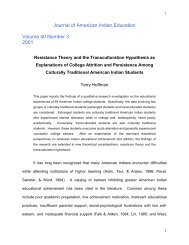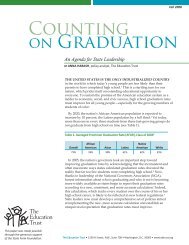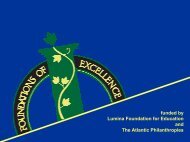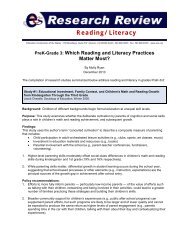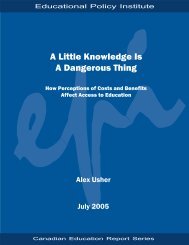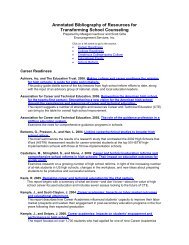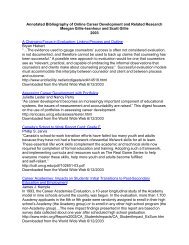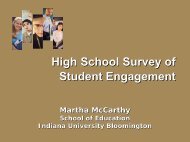Dual Enrollment of High School Students at Postsecondary Institutions
Dual Enrollment of High School Students at Postsecondary Institutions
Dual Enrollment of High School Students at Postsecondary Institutions
Create successful ePaper yourself
Turn your PDF publications into a flip-book with our unique Google optimized e-Paper software.
Characteristics <strong>of</strong> <strong>Dual</strong> <strong>Enrollment</strong> Programs<br />
Those institutions th<strong>at</strong> reported having high school students who took courses for college<br />
credit within dual enrollment programs were asked about the characteristics <strong>of</strong> their programs. The topics<br />
explored in the survey included course loc<strong>at</strong>ion, course instructors, program curriculum, academic<br />
eligibility requirements, and funding.<br />
Course Loc<strong>at</strong>ion and Type <strong>of</strong> Instructors<br />
<strong>Institutions</strong> with dual enrollment programs were asked whether high school students in the<br />
dual enrollment programs took courses on the campus <strong>of</strong> the institution, on a high school campus, or <strong>at</strong><br />
some other loc<strong>at</strong>ion. <strong>Institutions</strong> with courses taught on a high school campus were also asked whether<br />
the courses in the dual enrollment programs were taught by college instructors only, high school<br />
instructors only, or by both high school and college instructors. If institutions indic<strong>at</strong>ed th<strong>at</strong> <strong>at</strong> least some<br />
courses were taught by high school instructors, they were asked how the minimum qualific<strong>at</strong>ions for high<br />
school instructors who taught the courses compared to the qualific<strong>at</strong>ions required for college instructors.<br />
• Among institutions with dual enrollment programs, 80 percent <strong>of</strong>fered courses taken by<br />
high school students on their college campus, 55 percent <strong>of</strong>fered courses on a high<br />
school campus, and 12 percent <strong>of</strong>fered courses <strong>at</strong> some other loc<strong>at</strong>ion 6 (table 3).<br />
• A gre<strong>at</strong>er percentage <strong>of</strong> public 2-year than public 4-year and priv<strong>at</strong>e 4-year institutions<br />
<strong>of</strong>fered the courses taken by high school students on a high school campus (73 percent<br />
versus 47 and 28 percent, respectively) (table 3).<br />
• Of those institutions with dual enrollment programs with courses taught on a high school<br />
campus, 26 percent reported th<strong>at</strong> the courses were taught by college instructors only,<br />
32 percent reported high school instructors only, and 42 percent reported both college<br />
and high school instructors (table 4).<br />
• A smaller percentage <strong>of</strong> priv<strong>at</strong>e 4-year institutions had the courses taught on a high<br />
school campus taught by college instructors only, compared to public 2-year and public<br />
4-year institutions (10 percent versus 28 and 31 percent, respectively) (table 4).<br />
• Of those institutions with dual enrollment programs with <strong>at</strong> least some courses taught by<br />
high school instructors, 86 percent said th<strong>at</strong> the minimum qualific<strong>at</strong>ions for high school<br />
instructors were the same as those required for college instructors, compared to 6 percent<br />
th<strong>at</strong> said th<strong>at</strong> the minimum qualific<strong>at</strong>ions were different (table 5). Four percent <strong>of</strong><br />
6 The percentage <strong>of</strong> institutions with courses for high school students <strong>of</strong>fered on their college campus, on a high school campus, or <strong>at</strong> some other<br />
loc<strong>at</strong>ion sum to more than 100 percent because institutions may have <strong>of</strong>fered courses <strong>at</strong> more than one loc<strong>at</strong>ion. Other loc<strong>at</strong>ions included<br />
community centers, voc<strong>at</strong>ional/technical schools, and hospitals. Respondents also included online courses as “other loc<strong>at</strong>ions.”<br />
9



